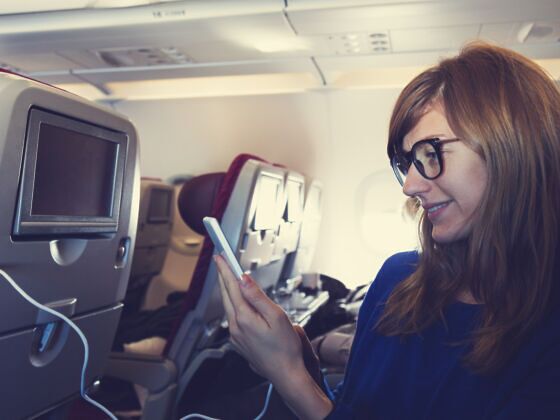Passengers on commercial flights have very little control over airplane safety. They can’t prevent door plugs from being ripped out of the side of the aircraft mid flight, or fix the shortage of air traffic controllers that has led to startlingly frequent near-miss collisions. But there’s seemingly one thing that passengers can do to make commercial flying safer: switching phones to airplane mode. It’s announced on every flight and seems like a no-brainer. Or is it? The science behind the airplane mode requirement tells a more complicated story.

Is Switching Your Phone to Airplane Mode During a Flight Necessary? Well, It’s Complicated.
The use of portable electronic devices during flights, including phones, was prohibited by the Federal Communications Commission in 1991. The reasoning was clear cut: The radio signals and electromagnetic waves that portable electronic devices transmit could potentially interfere with an aircraft’s navigation and communication systems.
A 2012 study led by the Federal Aviation Administration, however, lists anecdotal evidence from various airlines around the world that suggests phone usage does not create interference and has no impact on safety. Still, the in-flight announcements insist on switching phones to airplane mode a decade later.
While expert opinions and studies seem to differ on the topic of in-flight phone usage, one thing is certain: People do use their phones on airplanes, and seemingly do so without derailing everyone else’s safety. A poll carried out by travel insurance Allianz Travel in 2017 explains that “40 percent of people don’t always put their phone on airplane mode and almost 14 percent of people have secretly snuck a text message or call during a flight.” None of which seems to have made airplanes fall from the sky.
Telecommunication giants and the FCC have shown interest in making in-flight phone use safe. Picocells seemed to be the answer, and experiments were carried out to test its safety. As explained in a 2012 WIRED story, picocells can be compared to tiny cell towers to extend coverage in a building or, yes, a plane. When a picocell is installed in aircraft, passenger phones can get a connection without emitting signals that could possibly interfere with the plane’s essential navigation and communication functions. Picocells also have another benefit: They localize the connections so that cell towers on the ground near the airport aren’t overwhelmed by masses of people trying to connect while flying near them or waiting on the tarmac.
In 2014, despite contradicting evidence about in-flight phone usage and several studies that show picocell technology can prevent electronic interference, the FAA decided to keep the 1991 ruling in place. This time, however, radio signals and electromagnetic wave interference were not the only concern for why phones should remain off or in airplane mode: “annoying-seatmate issue” and “air rage” were added to the mix.
Even if picocells allow aircraft passengers to use their phones safely, having several hundred people talking and texting mid-flight leads to other risks. The most obvious being travelers getting angry at each other for holding loud phone conversations in cramped quarters, as well as not paying attention to the important messages delivered by flight attendants and pilots.
Whether they want to or not, air passengers in Europe will learn if mid-flight phone calls will lead to anarchy in the sky. Since November 2022, passengers aboard flights in the EU are technically able to use their phones for calls, texts, and data thanks to in-flight 5G connectivity and picocells (now required to be installed in all aircrafts in the EU). The US is likely to follow in Europe’s footsteps, but for now, the FAA and US airlines are still concerned that 5G could disrupt aircrafts’ radio altimeters, an essential instrument for safe flying.
As a frequent flier in both Europe and North America, I have not noticed the difference yet. I’m always asked to turn my phone to airplane mode, no matter what carrier I’m flying with or what country I’m in. I’ve never heard anyone take an in-flight phone call either, and I, for one, am not looking forward to the day when it’ll happen.
What I have experienced recently, however, is a pilot personally asking passengers via the intercom to switch off their phones. On a short domestic flight in France, and before our descent to an extremely foggy Paris, we were asked to turn off our phones entirely “because of the weather.” We were specifically asked to not leave our phones in airplane mode, but to turn them completely off.
On one hand, the EU says that you can go ahead and call your mom while you enjoy your Biscoff, and on the other, you have a pilot asking you to turn off your phone for safety reasons. That’s the best way to confuse everyone.
I asked Tyler Herbert, an experienced airline pilot in Canada, to explain the reasoning behind this pilot’s request. While he can’t be entirely sure of the logic behind it, he gave me his best educated guess:
“If you remember when 5G cell towers came online there were concerns they could affect aircraft avionics, specifically they operate in a similar bandwidth to Radio Altimeters. These Radio Altimeters are often used on approaches to very low minimums when the weather is poor. My only thought is that perhaps the pilots were operating an approach that would rely on the radio altimeter to determine minimums, and as a precaution cell phones were turned off to prevent any interference connecting to 5G towers.”
So, if the experts think an abundance of caution is the way to go, maybe we should follow their lead. If I’m asked to switch my phone into airplane mode or to turn it off, I don’t doubt the very people who fly the aircraft, no matter the reason behind the request. Whether that’s for safety or to keep us all quiet, we may never know, but I’d rather be safe than sorry.